
FAMILY
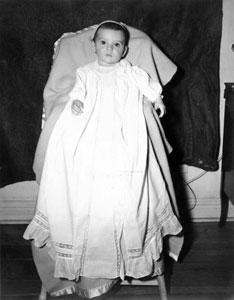
Myself, aged 5 months |
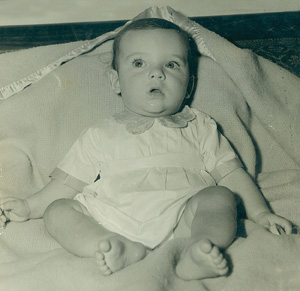
At the age of eight months in 1945. I seem to be unsure of something, and I still am |
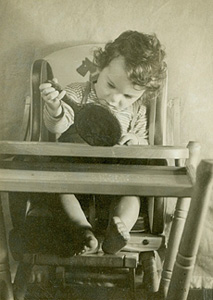
My first birthday, astonished at the strange |
|
|
|
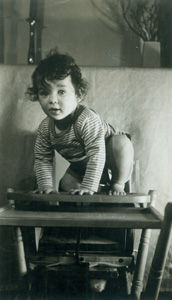
On the run at the age of one |
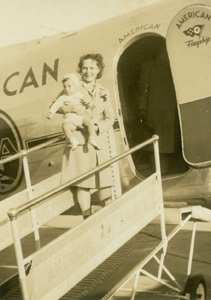
My first flight. My mother carries me onboard as a one year-old baby, in 1946. The plane was a Dakota, otherwise known as a DC-3. My mother told me when I was older, saw this photo and asked about it, that I stared at the clouds, transfixed, all the way. Unfortunately, I don't remember the experience. |
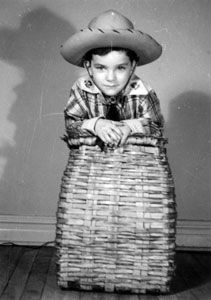
A reflective cowboy - me aged 3 |
|
|
|
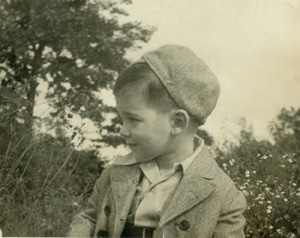
A wistful moment at the age of three. Possibly I was looking at some flowers. From that age I became obsessed by them, could never have enough, and with our friends Friedel Muschenheim from Wiesbaden in Germany, would go on 'flower raids' of peoples' gardens, gathering armfuls. We were always very careful only to take flowers from gardens which had plenty to spare, as we did not believe in a 'scorched earth' policy. |
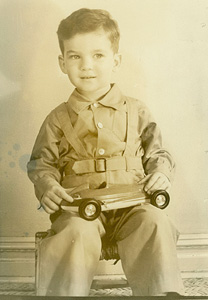
At the age of three I seem to have had a momentary interest in racing cars, but it soon passed, and has never returned. I have an aversion to speed in all its forms. |
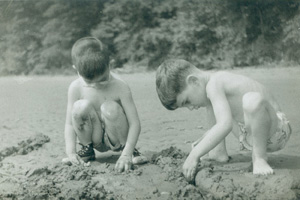
When I was very young I spent the summers at St. George's Episcopal Camp on the Hudson River. It was a camp run by St. George's Episcopal Church of Stuyvesant Square in New York City, and that delightful camp, which I enjoyed so much, no longer exists. Here another boy and I are deeply engrossed in playing in the sand beside the Hudson. We used to swim in it every day, for in those days people did not think about the pollution. The camp was divided into three sections: girls, boys and 'midgets'. The latter were people under the age of seven, the girls and boys under that age being put into the same building. ... more» It was called 'Midget Camp'. I never graduated beyond Midget Camp, due to moving to Kentucky at an early age. I was very fond of the two counsellors Hazel and Perry, who were champion swimmers, and who later married each other. They were always coming back dripping wet, having swum across the Hudson and back just for pre-breakfast exercise, or pre-supper exercise, or whatever. Any excuse would do! I remember during this summer when I was four listening to the radio intently, and my favourite song, which was the number one hit then, was 'Truly Bear'. The two things which fascinated me most at camp were the empty shells of the locusts which they left behind on the pine trees, and which I used to collect as a youthful naturalist, and the chicory flowers which grew in abundance by the roadsides, the exquisite blue of which thrilled me. I was also thrilled by the profusion of snapdragons growing everywhere, as their shape delighted me so much. In those days, life up the Hudson was extraordinarily tranquil, at places like Saugertes and Poughkeepsie, which we occasionally visited. They were sleepy little towns with drugstores where people sat and sipped their ice cream sodas and there was no such thing as crime. I have recollections of the sunny streets filled with those old 1940s cars and girls in bobby socks and chewing gum in my mouth which tasted good (juicy fruit being my favourite flavour, closely followed by spearmint), and how hot it was in the cars but how strong the sun was outside the cars, and how the counsellors flirted with each other innocently, and how the kids let themselves be led around dreamily, not protesting. I remember one day one of the girl counsellors asked me whether I thought she should wear her blue shorts or her green shorts. I said the blue, and she wore them. I was deeply flattered to be asked by a real grownup when I was four to help her make a major life decision, and glowed with pride about that for weeks, and that I had been listened to and taken seriously. Her decision was important, you see, because she wanted to look pretty for her boyfriend, and did I think blue or green made her look prettier. However, I was careful to say that the green looked good too, just not as good as the blue, so that made her happy as well. What a cheerful girl she was, in fact everyone was. |
|
|
|
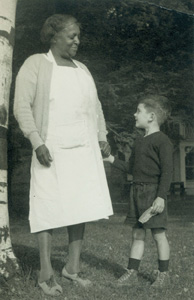
I loved this woman, and was always holding her hand. She was the laundress at St. George's Camp on the Hudson River, where I spent the summers when I was ... more» very young. She treated me as her favourite and gave me sweets and sat me on her lap. Her white uniform was always very crisply starched and smelled clean and was crunchy against my face. She wore a fresh one every day. She always smelled of soap, as she seems to have scrubbed herself as energetically as she scrubbed all the clothes and bedding. She had an artistic temperament, as she meticulously hung out all the laundry to dry in matching colours, and would never allow a colour clash on her washing lines. She was in charge of all the personal and bedding laundry for at least a couple of hundred people, so it was a very demanding job. I cannot remember the woman's name, but I think it may have been something like Sadie. However, because I never called grownups by their first names when I was a child as it was impolite, I always called her Mrs. something or other, and cannot remember what that was. She is standing beside a birch tree. There were many of them at the camp, I loved their peeling bark, and used to collect 'pieces of paper' which I had peeled off the trees, and tried to write on them. (I could write by this age, four, since I began reading at three). |
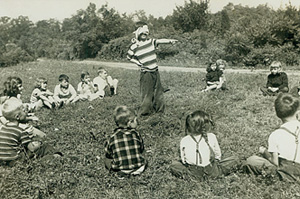
I am standing in the middle of this game of Blind Man’s Bluff. I am aged four, and having a wonderful summer at St. George’s Episcopal Camp near Saugertees, New York, on the banks of the Hudson River. |
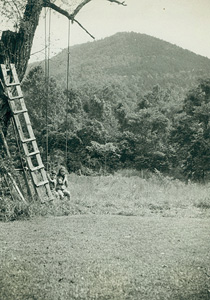
Me and Lida Martin on adjoining swings in Virginia |
|
|
|
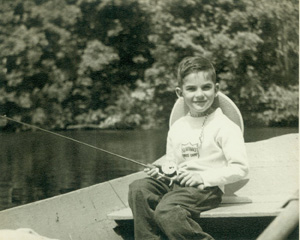
My fishing career began and ended at the age of four, seen here. I caught some little fish called sunfish, and was distressed to see that they flapped and squirmed ... more» and leapt around. I wondered how anybody could do this to these poor little creatures, especially only for sport. Clearly, if one needed food, that was a different matter. But the idea of going fishing for sport nauseated me after I saw the suffering little creatures, I determined never to do it again, and I never have. |
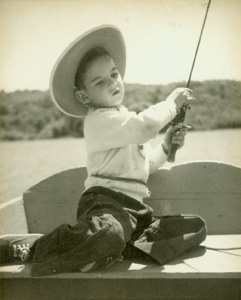
Fishing for sunfish, aged four |
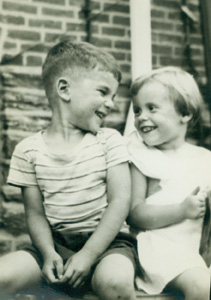
I have always enjoyed chatting with girls. Here I am flirting with a girl named Carol Hundertmark, whose mother was my mother's friend. They lived in Doylestown, ... more» Pennsylvania, which we visited a few times, including once at Christmas when it was snowing, when I remember they had a really splendid tree. Her surname meant 'a hundred marks' in German, but as far as I know she never otherwise had a price on her head. I lost contact with her later, which proves just how fickle girls who lead boys on can be. Doubtless she found another boyfriend, and showed her toothy grin to him instead. Probably she now has grandchildren who look just like her. This photo was taken by my mother. |
|
|
|
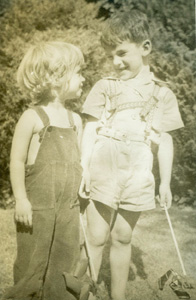
Me and Carol Hundertmark |
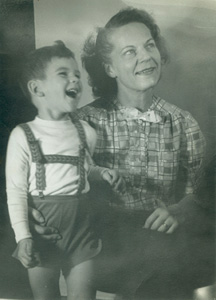
My mother and myself enjoying a moment of mirth. I remember those shorts were too tight. |
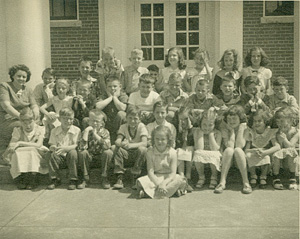
This is a group shot of my third grade class, taken by my mother. At left is Mrs. Lexie Dean, our teacher for every subject. She was a truly wonderful person and teacher. I hid at ... more» the back and you can only see the top of my head in the centre at the very rear. I have always hated the idea of being part of any group, and sitting complacently as part of this group was unacceptable to me. In any case, I was a year younger than them all and I was so much smaller, they rarely noticed me. The little girl sitting in front, whose name was Janet, was the most popular girl in the class, but she was incredibly vain and was real 'trouble', often pouting and primping. I remember many of these children very vividly. The boy at the left of the back row with the dark hair was a very jolly, affable fellow, who wouldn't harm a fly. The fat boy sitting in front of the boy at his left and sticking out his tongue impudently was a thug and an oaf, always picking his nose and being objectionable. He was the kind of kid who tortures animals and pulls apart insects. I think he was called Jimmie. The boy to the left of me (on my right) with the blonde hair was called Donald. He was pleasant and affable. The girl at the end on the right of the back row had red hair and was very sweet, and liked me, and I liekd her, but only in the Platonic sense. The girl beside her was also very nice. The boy second from left in front was a quiet, harmless little chap with very poor eyesight, who rarely spoke, and was hopelessly shy. The girl second from the right in front was a very pleasant extroverted girl, always friendly to everyone, and smiling happily at all times. It was during this year, 1951-2, that I fell in love for the first time, at the age of six. The girl was called Barbara Hatcher, and she is not in the photo. I believe she was part Cherokee, because she had beautiful brown skin and dark hair. For some weeks she wore her arm in a sling, which she had sprained or broken. She was always adopting dramatic poses with her injured arm, imagining herself a wounded heroine. She never took any notice of me, but then I was younger and smaller and not worth speaking to. The next year she moved away and I never saw her again. Because I was top of the class and way ahead of the others academically, I skipped the next grade at Lexie Dean's recommendation, and thus became two years ahead of myself after this, which made me even smaller and even younger and even less worth speaking to by the charming girls in my classes who never noticed me except to think me cute like a baby, whom they might occasionally protect if they were feeling maternal. Lexie Dean had a son called Jimmie Dean, a bit younger than myself, with whom I played sometimes. We liked climbing fences and walls together. But it was Lexie's daughter Judy Dean who was really marvellous. She was wonderfully bold and noble, a few years older than me, and she once saved me from being beaten up by a gang of big boys in the snow by challenging them all to fight her and calling them cowards. They ran away, humiliated, and I was saved that time. She was the only person who ever intervened to save me when I was being attacked by gangs of big boys who hated me because I was intelligent and made them feel inadequate (which it is perfectly true that they were). This quaint little school was closed after this year, in 1952. It was called the Hickman Street School, and it was a delightful little place which should have remained open, as everyone was happy there. But 'the powers that be' decreed that it was too small, too cozy, and that kind of thing had to make way for bigger schools such as bureaucrats prefer. Anyone who ever studied under Lexie Dean as a child is bound to remember her. She was so good-natured, smiling, patient, and kind, that she was really the model teacher. This year was really something of an idyll, not just for me, but for all of us who were there. It was while playing in the yard beside the school one day that I lost a precious object. My grandmother, the one who had lived with the Indians for a year, had been given a beautiful silver ring with a magnificent thunderbird carved in turquoise by her best friend amongst the Sioux, Sitting Bull's granddaughter. I believe it had belonged to Sitting Bull's daughter and been made for her at the orders of Sitting Bull. I was obsessed with jewelery when I was a child, and used to spend hours drawing fantasy rings, bracelets, and necklaces with my crayons. I would stare for ages at jewels in shop windows. So I was spellbound by the magnificent thunderbird ring, and one day persuaded my mother to let me wear it to school, to show to the other children. They were all agog when I told them of its provenance. It must have slipped off, because when I got home it had vanished. I am sure one of the other children pocketed that ring, and that it is still somewhere in Kentucky squeaking in protest that it wants to come back to me. But thunderbirds cannot fly across the Atlantic, so I am told. I was so depressed at being responsible for the loss of so precious an object that I was in gloom about it not for months but for years. I resolved never to be such a careless idiot ever again with an object which was of such historical importance. In fact, I still feel terrible about it. The worst thing is that whoever has it does not know its true importance or its story. And it is the story that ultimately matters, for everything and everyone. |
|
|
|
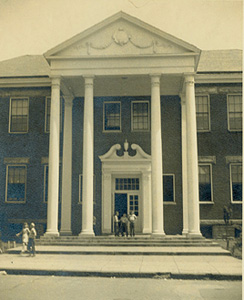
My life in the Third Grade. The entrance to Hickman Street School, which was a charming and relaxed place which all the students and teachers loved, so naturally it was closed down the next year. |
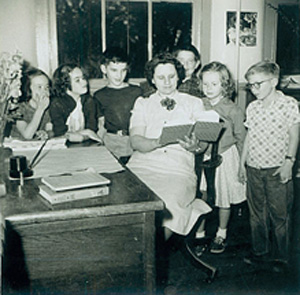
A photo taken by my mother of my favourite teacher, Mrs. Lexie Dean, surrounded by some of her favourite pupils. I am to the left of her, looking over her shoulder at the book. I was her favourite pupil because I was top of the class. |
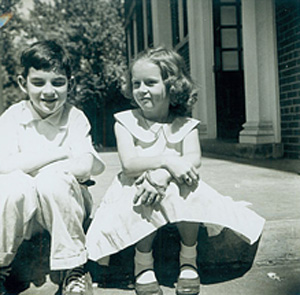
Sitting on the steps of the school with a girl in my class named Janet, who alternated between being charming and really horrible. |
|
|
|
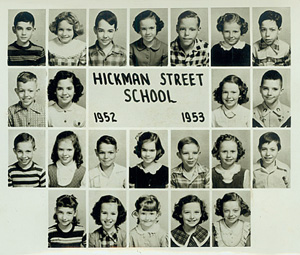
A ‘class photo’ of my Third Grade class. I am at the top left. Most of the girls were really nice, and possibly the sweetest natured was the one at the left of the bottom row, but ... more» there was a lot of competition to be sweet, as most of them were that way. Most of the boys in my class were also very pleasant. It was a quiet, peaceful year. At that time, I was only one year younger than my fellow-students, and the stresses and strains of being two years younger had not yet begun. However, I skipped the next grade, went to another school where I was the only Protestant amongst Catholics, and then social relations became difficult, as I was from then on ‘the midget’ who annoyed everybody because he still got the best exam results and who additionally had been damned by Almighty God to go to Hell because of not believing in the Virgin Mary etc. etc. I never saw any of the nice children in the above group photo again, and never knew what happened to any of them except I would occasionally catch a glimpse of one in the distance in the street walking with his or her parents, as distant as Alpha Centauri, since children of that age do not rush up and greet one another. It is as if they had all vanished off the face of the Earth. I still wonder about them, as I really liked being with them all. If Hickman Street School had not closed, we would all have continued going to it and been very happy, and I would probably have insisted on staying in the same class with my friends, which would have had a drastic effect on my future life. Some things are destined, usually the things which are most uncomfortable. I did, however, keep in touch with Mrs. Lexie Dean and used to visit her at home long after these days were over. |
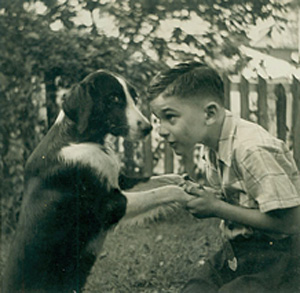
They say that a dog is ‘man’s best friend’. Never was it truer than for me. This is my best friend Rusty. She was not so much a sister as a mother. She looked after me. And ... more» that was not easy, because in the course of her active life as a woman, she also had 32 puppies; two died, 30 survived. I was their uncle and helped her to look after them and get them properly licked clean (she did the licking, I did the holding while they struggled). The pups were spread over six litters, so we had plenty of time. In this photo, Rusty is not pleased that we are being spied on by my mother. She and I slept in the same bed together, at least before she started having all those pups, when it became impractical. Rusty was a cross between a border collie and an English setter. She both herded and pointed. She had ‘feathers’ on her legs, as may be seen. I named her Rusty because she was black and white. That’s the way I am, and the way she was. We enjoyed being nonconformists together. Our favourite thing to do together in the summers was to climb onto roofs and look down. There was one garage we liked, which was beside an enormous old wild cherry tree. We could sit in the sun until we were too hot, and then move into the shade until we got too cool, and then move back into the sun again. We would spend a whole afternoon just snoozing like that and watching the sun through the dappled leaves of the old cherry. That particular garage roof could only be reached by standing on a single fence post, so that in order to manage it, Rusty had to balance all four paws on a post, like a circus dog, and then suddenly make the leap up. Rusty’s best friend in the dog world was Jeff. He was an elderly and wise Dalmatian, and a great pal of mine too. He was the father of some of her pups. His masters were Mr. and Mrs. Spahr, who were very charming and treated him with the respect he deserved. Jeff had a brother and sister called Roger and Martha Spahr, who were humans. I used to climb a huge persimmon tree in their garden with them, while Rusty and Jeff looked on enviously, as they could not do that. Rusty’s other best dog friend was a really doddery old boy whom I called Mr. McDoodle, as no one knew his real name. Mr. McDoodle was not a boyfriend, just a great-uncle, but Rusty was devoted to him and shepherded him across streets at night to make sure he got home safely after one of his social visits. He was deferential to Jeff, so there was no trouble. Rusty was a wandering dog aged about one or two when she spotted me in the street and adopted me. My mother gave her away to a farmer against my tearful protests, but Rusty found her way back to us alone, a distance of six miles, so then my mother agreed that a dog with that determination and ‘spunk’ could stay. No boy ever had a better friend than Rusty. She was not ‘just a dog’, she was a spirit. |
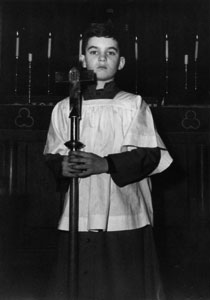
This is a photo my mother took of me when I was eight years old. I had just become an acolyte in our Episcopalian Church (what is known in England as the Church of England). I remember ... more» vividly the smell of the polish on the brass cross which I was carrying, on its pale wooden pole. The outfit consists of two garments, as I was informed: the maroon one underneath was a cassock, and the white cotton top was called a cotta. It always smelled clean, because some good woman was always washing it, and it was slightly starched as well, therefore cool on a hot day. I think it had had to be bought new for me, as I was by far the youngest and smallest acolyte they had ever had. I loved the smell of the frankincense and myrrh, and although I didn’t get to swing the censer, because I was too small, I got to carry the incense boat and feed the censer. I have always been a great lover of fine scents and aromas, and have a dog’s acute nose. It was my job to light and snuff out all the candles on the altar behind me. I enjoyed doing all this, except that I hated the tedious and endless Stations of the Cross on Good Friday. I was never attracted to all the moaning and groaning and blood and gore and dead bodies on the cross that so excited a certain sort of weird religious person, and I thought the bare altar on Good Friday was shocking. I could not wait for the lovely smell of the Easter lilies and a bit of joyousness. I was confirmed at this age, which was rather young. The priest used to get extremely impatient and frustrated with me when I would go to confession, because I couldn’t think of any sins, and the ones I ‘confessed’ were so pathetically inadequate as sins that he obviously thought I was a hopelessly feeble goodie-goodie. I used to wonder if I should commit some genuine sin just to make him happy, so that he could have something to absolve me of, but I never could think of one. I hadn’t committed any sin since I stole baseball cards from another boy at the age of three, which I regretted bitterly ever afterwards. I was only allowed to confess it once, and couldn’t keep repeating it, because you aren’t allowed to go over your old sins again. When I was this age, all the women used to stop me in the street and tell me what a pretty little boy I was, and how long my eyelashes were. I hated being called pretty, and used to deny it furiously. |
|
|
|
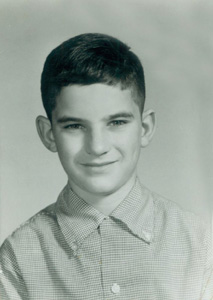
A school photo from Kentucky when I was about eight. The checked shirt I was wearing was too big on purpose because I was supposed to 'grow into it'.
|
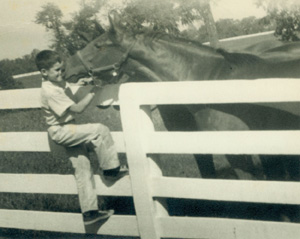
Aged ten, rubbing noses with a couple of two year-old mares at Calumet Farm in Kentucky. I would whinny and they would all run from the far fence half a mile ... more» away to greet me. I was always more popular with horses and dogs than I was with people. I was the only person who could quieten the magnificent black stallion, 'the Son of Bull Lea', who was always hobbled because of his violent nature and was seriously grumpy. I could calm him completely, and all his fears evaporated. |
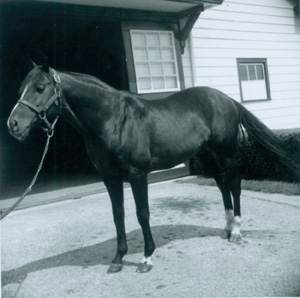
Another friend of mine, Citation, one of the champion race horses of all time. He was a placid bay, a wise old fellow, who never made any trouble and kept his thoughts to himself. |
|
|
|
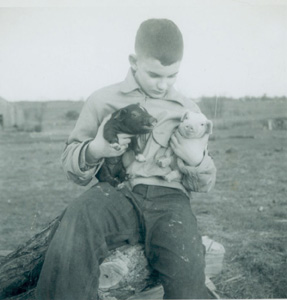
I had these two pet pigs when I was about ten in Kentucky. However, I was heavily persuaded that I could only have one, so I surrendered the dark one and kept the little ... more» pink chap, who was far more engaging in his personality. I called him 'the Red Runt', as he was a red pig and was the runt of the litter. He was so comical, I never had a dull moment with him. Pigs are almost as nice as dogs, and are extraordinarily intelligent. I highly recommend them as pets, and when they are this age it is all right for them to run around the house, as the only danger is pools of pee. However, they later get such scaly skin, and they will rub up against everything and shower a room with their dandruff, and they have an incurable desire to rush for any mud and wallow in it. I suppose their habits are anti-social, but their charm makes up for it. |
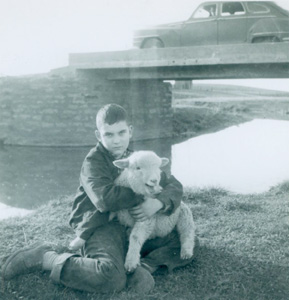
I had this pet lamb for a while, but he was very stupid, I am afraid. I came to realize that sheep lack the intelligence to be acceptable pets, and pigs are far preferable. I did try ... more» once more with a lamb, with a black lamb in fact. He was being persecuted and butted by the ram, who wished to exclude him from he flock. But although the black lamb was brighter than this one, he was still a dumbo, and it all came to nothing. In any case, I had my dog Rusty and did not really need a lamb, or even a pig, for that matter. But there is no denying the fact that lambs are very delightful to hold, with their soft downy fleece, and one wishes they were less hopeless as characters, for if they only had some brains, they would be the ultimate cuddly toy that moves and bleats and actually responds to your gaze. But they are always looking away, like autistic children. |
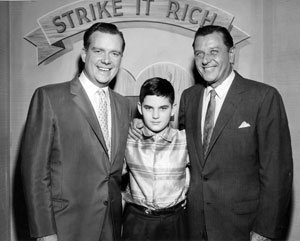
When I was 11 I did a TV show with these two fellows and I got to know Don Ameche at that time. |
|
|
|
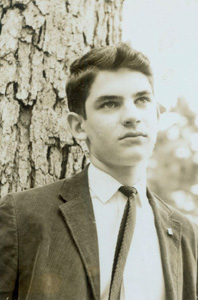
A snapshot when I was fourteen or fifteen. At that time, it was the fashion to wear ultra-thin ties, and I was very keen on this one which was dark green. It was briefly stolen ... more» by another boy who coveted it, a classmate named Frank Parratt, but when I complained to him, it mysteriously appeared again, somewhat rumpled but essentially intact, lying just outside the back dormitory in a rain gutter. I rescued it just before a coming rain storm arrived. I bought that tie in Louisville, and was not amused at the theft, as I didn't want to have to go back to Louisville to replace it. If I like a tie, I like a tie, and I don't want to be messed with. I am wearing a dark green cordouroy jacket, which everyone was wearing in those days. At that time, it was hard to find a young man anywhere who was not dressed in cordouroy. In fact, if you weren't in cordouroy, you weren't anybody. I have long since abandoned all pressures of fashion, but kids are susceptible because they want to be accepted, and even I was not immune to the occasional temptation to be accepted, although those were certainly moments of youthful weakness, and I now hope I shall never be accepted by anyone anywhere ever, as I look upon acceptance as a surrender of one's individuality. I don't regret the cordouroy in this case, however, because I actually liked it. Cordouroy is very comfortable, and highly to be recommended. The photo was taken at my boarding school in Tennessee. |
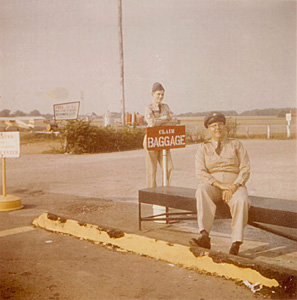
Here I am in the summer of 1959 (the smaller figure) in my Civil Air Patrol sergeant's uniform, aged 14, with Mr. Mattingly, a delightful man (partially handicapped ... more» with a stroke) from Frankfort, Kentucky, who taught me something about radio electronics and delivered me on this particular day to this airport at Lexington, Kentucky (Bluegrass Field), from where I flew in a C-14 cockpit to the C.A.P Encampment at Memphis, Tennessee. After that experience of the Encampment, where the other kids voted me Honour Cadet because I could cuss the best of anyone in my barracks, I was qualified and became an officer in the C.A.P. At this tender age, I was therefore the youngest person in the USA ever to do that. As the rules stood at that time, if you became an officer in the Civil Air Patrol, you were looked upon as qualified to skip basic training in the U.S. Air Force and go straight in as an airman. I qualified for this four years early! I had to pass lots of exams in things like aerial navigation, radio communication, aerodynamics, how aircraft engines work, and so on. I was also a keen volunteer in the Ground Observer Corps, and I had memorized the silhouette of every Soviet plane 'just in case' and took part in observation exercises. (That Corps has long ago been closed down, as it was a relic of the Second World War, when aerial spotting by ground-based observers actually had a useful purpose). In those days I thought maybe I would go into the Air Force when I grew up and become a Colonel, recognising of course that this could not happen immediately, but would require some polite delays such as being promoted from Major first. I wanted to be a jet pilot, as all boys do. I visited many Air Force bases, and spent a couple of weeks at Barksdale AFB, Louisiana, with a friend whose father was a genuine Air Force Major (the thing I hoped to be promoted from one day). I used to love watching the B-52 bombers sitting there with their wings drooping, and then rising up as they took off. I was never allowed inside a B-52, but I did look up through the bomb bay doors of one, and stood beside many. I was allowed inside a KC-135 in-flight refuelling aircraft, and lay on my belly looking down the feeding tube which would go into a B-52's nose in mid-air. That was great fun, and a high point. I flew in numerous aircraft, such as that helicopter which is bent at an angle and looks like a flying hockey stick (can't remember its number). Flying in that with the side doors open and my head sticking out was very thrilling. But it was terribly noisy and not at all good on the ears. I visited the Air Base at Columbia, Mississippi, which impressed me a great deal. It was exceedingly hot down there, so hot I lost my enthusiasm for the planes and just wanted to get back into the shade. The base at Memphis was really boring and not of any real consequence. I was certainly a great fan of the Air Force, and had the highest possible opinion of General LeMay, head of the Strategic Air Command, who was a hero to all of us in the C.A.P. at that time. People of my inclination were rather annoyed when Stanley Kubrick made fun of 'our' planes in the film Doctor Strangelove, and we thought he really didn't know what he was talking about (or filming about). I was really angry with him for not appreciating KC-135s seriously enough. I suppose my favourite plane was the unbeatable C-123, in which I rode so many times. It was designed as a glider in the War and then they thought what the hell why don't we stick engines on it, and it was one of the great aerodynamical triumphs in the history of aviation. A pumped-up version of it was later developed, using the same design enlarged, and it was called the C-130, better known as the Hercules. Now, that is one hell of a plane! What a wonder! I never served in the Armed Forces, being medically disqualified when drafted in 1966. |
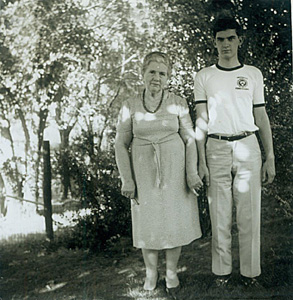
The summer of 1961, when I was 16. This was the last time I ever saw dear 'Georgie P.' She was like a foster mother to me when I was a child in Kentucky. Her maiden name ... more» was Prater, and she was a mountain woman from Owensboro. When very young, she married a farmer named Mr. May, who died and left her a widow with eight children and no money. She was extremely brave and had tremendous character. She brought up her family by working as an itinerant tombstone saleswoman (she preferred to call them 'monuments'). She was successful because of her deep Baptist religious beliefs, and her genuine ability to sit and cry with the recently bereaved. She drove all over Kentucky in her little car and sold the tombstones to farming folk in remote places, using her catalogue and helping them to choose which kind of marble, which kind of angel, and what Biblical inscription would be appropriate. They were all deeply religious people in that part of the world. Georgie P. liked to go to prayer meetings in tents, just like in Elmer Gantry. She took me along to a few. People really threw away their crutches, sobbed, and accepted Jesus as their Saviour with whoops of joy and wild cries. The gospel singing was terrific, but these were all-white events, as black folk had their own separate revival meetings, and didn't want any white folk there at such a private time. No one was banned from either the black or the white revival meetings, but there was a wholly natural segregation of colour by mutual complicity. Georgie P. was a great cook, on the epic scale. A meal for her had to have at least thirty courses. Her cooking was traditional Southern, with the most amazing mountains of delicious fried chicken, a huge country ham, rows of baked cornbread, collard greens, every vegetable you can think of, plates of cheese, pickles, bottled and fresh fruits, endless pies and cakes, heaps of steaming corn on the cob, bowls full of devilled eggs, salads, everything the heart could desire. Never any alcohol, as she was so devout. But as much fresh milk, tea, coffee, cool aid, lemonade, Ale-8, Doctor Pepper, root beer, and fruit juices, as anyone could want. Georgie P. was the closest I ever met to a real Mother Earth and Mother Courage. She was one hundred per cent good, and never had a wicked thought in her life. Everything she did, she did with love and generosity. Her two favourite people were her granddaughter Miriam Lee May and myself. Georgie P. looked after me when my mother wasn't feeling up to things, which was very often indeed. She did this out of the goodness of her heart, as we never even knew her until she met me one time when I was in distress at the age of six and took me to her heart evermore. Towards the end of her life, Georgie P. found a new love, the sweetest little girl named Lee Anne, who had been adopted by Georgie P.'s daughter Kathleen and her husband Omar Brandenburg. Lee Anne was a bed-ridden invalid, beatific like an angel, who died young of her debilitating disease. She and I used to correspond. On the rare occasions when I was able to see her, I would tell Lee Anne stories about mythology, and her greatest enthusiasm was for the winged horse, Pegasus, perhaps because he was free to fly. I still get all choked up when I remember Lee Anne, and Georgie P., for that matter. There was never a more sympathetic, loving, 'Christian', and understanding woman than Georgie Prater May. She had the most mesmerising gift of story-telling. She could tell stories, many of them ghost stories, for hours on end, and she was the Last of the Great Story-Tellers. It was pure magic and entrancement. Georgie P. represented another age, an age of verbal legend, she was a Homer, she really was. |
|
|
|
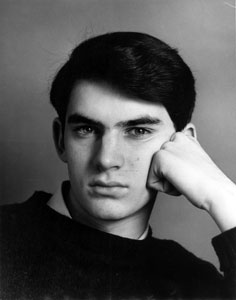
Myself, aged 18 |
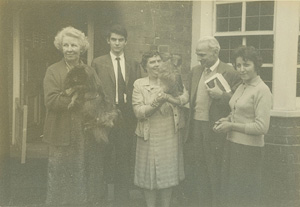
A photo of me in Reading, Berkshire, in the summer of 1963, aged 18. At left is Sammie Mitchell-Hedges, discoverer of the rock crystal 'Skull of Doom', at the Maya ... more» ruins of Lubantuun, and adopted daughter of the adventurer F. A. Mitchell-Hedges. Sammie also owned the Black Virgin of Kazan icon, which has on its gold riza the world's largest emerald. It was credited with turning back Napoleon's assault on Moscow. The woman in the middle is Cynthia Fowles, Sammie's personal secretary. The girl on the right is Sammie's niece Solange, from Quebec in Canada. The man is my good friend Prince Friedrich Ernst van Sachsen-Altenburg, the archaeologist and guardian of Anna Anderson, claimant to be the Grand Duchess Anastasia. |
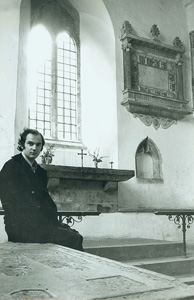
Ancestral reflections. Here I am in the 1970s sitting on the tomb of Peter Temple (from which the brasses disappeared centuries ago) and on the wall behind is the memorial ... more» plaque to his son John Temple (1542-1603) and his wife Susan Spencer (they were married November 24, 1561). The church is All Souls Church, Burton Dassett, Warwickshire. Olivia and I lived at Burton Dassett in the 1970s. The stone base of Peter Temple's 16th century windmill still stands on the Burton Dassett Hills, where it is mistakenly called 'the Beacon' by the locals, who wrongly imagine it was built to send bonfire signals! From the Hills, you can look down over the site of the Battle of Edgehill which took place in 1642 at the beginning of the Civil War. The Hills used to be very tranquil and idyllic, but the peace was ruined by the construction of a noisy new road below in the 1980s, and by a massive plague of tourists from Birmingham and Coventry, who come to the 'Burton Dassett Country Park' and cause traffic jams and leave litter and have destroyed the peace of the place. The trouble is that Britain is grossly over-populated, and nowhere is quiet anymore. The 'consumption of places' by the hordes of people who infest Britain in their tens of millions is now so intense, that the only way to get away from them is to go somewhere inhospitable like the north of Scotland, unless of course one is prepared to contemplate suicide, which might be another method of escape. It depends how desperate you are. Now one cannot even travel on a train without being forced to overhear the inane conversations about nothing by mindless folk who suffer from mobile phone addiction. It used to be possible to sit quietly on a train, lulled by the sound of the wheels, and reflect upon things peacefully: do you remember? I used to love entering Burton Dassett Church in order to experience the quiet and peace of a magnificent mediaeval building resting lengthways on a steep hillside like a massive beached ark, come to rest after the Flood. This photo is taken in a little side chapel. |
|
|
|
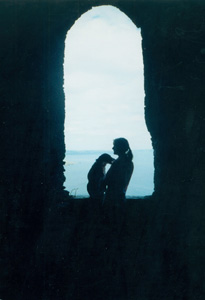
Olivia and our dog Kim silhouetted in the ancient window of the ruined chapel at Rames Head in Cornwall. I always think of this ... more» remarkable building as the archetypal site of the 'Ordeal of the Chapel Perilous' in the Arthurian Legends. |
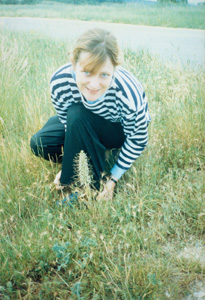
Olivia crouching over an orchid which we discovered in a field on one of our walks. |
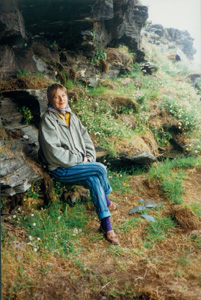
Olivia taking a break on a windy walk by the sea in Cornwall. |
|
|
|
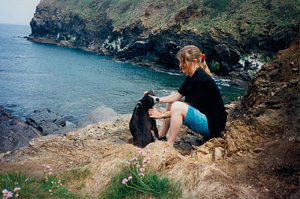
Olivia and our precious dog Kim at the sea in Cornwall. Kim is looking at me with smug satisfaction and saying: 'I've got her! She's mine!' about Olivia. Olivia was Kim's 'Mummy', and was the Aplha Male of our pack, with me being only the Number Two and a mere hanger-on. |
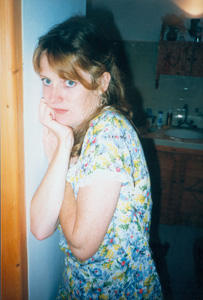
Olivia could have been an actress. Here she is pretending to wonder what to think of me. |
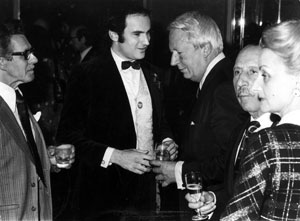
Me chatting to Edward Heath in 1976 at a publishers party. On right, Sir Charles and Lady Forte. |
|
|
|
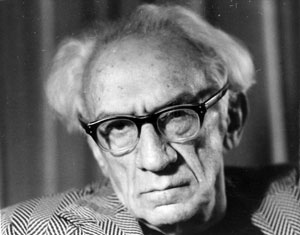
Immanuel Velikowski, author of Worlds in Collision. I took this photo in the late 1970's. |
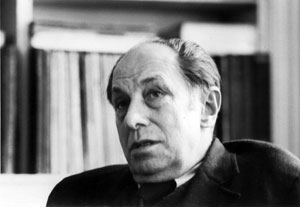
Livio Stecchini, co-author of Secrets of the Great Pyramid. I took this photo in about 1978 at his home in New Jersey. |
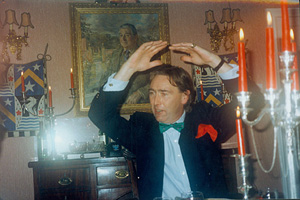
This is John Cely-Trevilian, who was my best friend, and who died in 2006 of cancer. He is making a typical histrionic ... more» gesture, at dinner in his wonderful Tudor manor house of Midelney, in front of the portrait of his father. John is deeply missed, and, being unique and irreplaceable, has left a gaping hole in the Universe. |
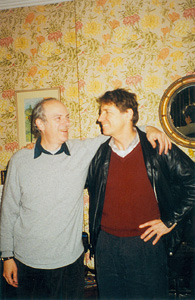
John O'Reilly |

This is my childhood friend Buddy Rogers, of Winchester, Kentucky. He owns and runs the Ale-8 company, which produces my favourite soft drink. (Alas, I have ... more» to carry back only a few bottles from rare visits to Kentucky, so I am seriously under-supplied). Ale-8 is from a secret recipe dating from 1902 and is far superior to any other soft drink in America. (Coca-Cola and Pepsi-Cola, watch your step! I wouldn't dirty my mouth with your foul and disgusting brews!) Buddy is a highly expert and specialist jewel collector, and assisted me in my research into emeralds for my book 'The Crystal Sun' (see that book's acknowledgements). Buddy has shown me yellow diamonds, red diamonds, grey diamonds, blue diamonds - it's astonishing how many colours those supposedly white stones come in! Buddy and his sister Riley were two of the nicest kids I knew when growing up. I once pulled the most terrible trick on Buddy's mother. I bought a fake 'ink spill' from a joke shop in Lexington and placed it on her new white carpet, and Buddy and I looked at her with mournful faces and I confessed to having spilled a bottle of ink. Poor Mrs. Rogers, it took her years to recover from the horrible shock. Even when I jumped up, alarmed at her reaction, and showed her that the ink spill was made of shiny metal and was fake, she would not be quieted, but continued in a worrying state of shock. My practical joke was never forgotten, nor, I think, wholly forgiven. I think Buddy and Riley still chuckle about it, but then, it wasn't their carpet. I became more careful with my practical jokes after that traumatic episode. |
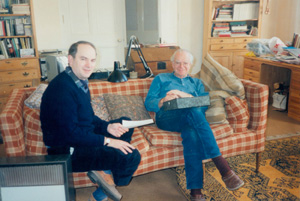
With my friend Peter Mitchell, in his house, Glyn, in Cornwall, about 1980. Peter was one of the world's most brilliant and original scientists, and he won the Nobel Prize for ... more» Chemistry in 1978. He used to call me his 'co-conspirator'. By that he was not referring to any expertise I had in cell biology or bioenergetics (for I have none), but to the fact that we were both passionately devoted to the destruction, wherever possible, of the stifling intellectual aridity and hypocrisy of the 'official world' and of 'official academia'. Peter strongly recommended me for a Guggenheim Fellowship for some of my research, but the Guggenheim people just couldn't go that far, because I am simply 'too much' for people like that to take. My ideas are so unconventional that no matter how many distinguished people like Pete have tried to help me over the years be accepted by something remotely resembling an Establishment, it was hopeless, and after a great deal of frustration and complaint, they all finally had to admit defeat in standing up for me. We had some delightful holidays with Peter and Helen in their ancient house in the south of France. This photo captures Pete's mischievous and conspiratorial smile. As Olivia pointed out when I came across the photo, it was the same smile he got on his face every time he was about to open a bottle of ten year-old Volnay. Pete, whom we called 'Beet', a name given to him by a grandchild and which he kept, was one of the most reclusive, modest, and retiring of the major scientists of the twentieth century. Few people knew him. He was one hundred percent original. No second-hand thought ever entered his brilliant mind, even for a milli-second. He suffered the humiliation of savage and vicious attacks for over twenty years by people calling him and his theories crazy, and then suddenly when they were proved to be correct, he got the Nobel Prize and all his critics had to shut up. Once in a while, there is justice! Photo by Olivia. |
|
|
|
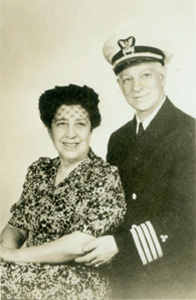
These are Mr. and Mrs. Goetze, who were two of my godparents. Mr. Goetze was a Captain in the Merchant Navy. They were both English, although they lived in ... more» America, and it was from them as a small child that I learned about English tea. They were passionate monarchists, and Mrs. Goetze's favourite subject of conversation was King George VI, whom she adored. I think she had even met him once with her husband, at a Buckingham Palace garden party. She told me constantly that a nice little boy like me should end up living in England, because I would be able to appreciate its higher civilisation, and I must have taken her seriously, becasue thats what I did. The Goetzes were absolutely delightful, always friendly, smiling, and welcoming with a pot of tea. Mrs. Goetze taught my mother to knit, something which she then never stopped (almost doing it manically day and night from then on, it seemed to me sometimes). Mrs. Goetze used to try to persuade me to learn to knit, and gave knitting her highest possible recommendation by informing me solemnly that King George VI himself knitted! I expressed my incredulity and disbelief at this, but I am sure it was true. However, I resisted all efforts to persade me to knit, much to Mrs. Goetze's disappointment. However, even though I was a disappointment to her on that score, she and her husband were an even greater disappointment to me politically. At the age of three in 1948, I was a passionate supporter of Tom Dewey for President, and I was a great hater of Truman. The Goetzes assured me that they were going to vote for Dewey, but then they changed their minds at the last moment, as many millions of Americans did on Election Day, and switched to Truman, who won. Although they apologized to me very solemnly afterwards, I never recovered from this deep shock. From then on, I realized that even the nicest people cannot be trusted to act sensibly in political matters. |
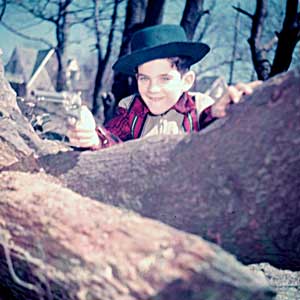
|
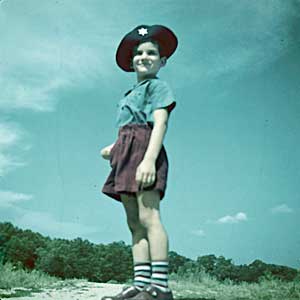
|
|
|
|
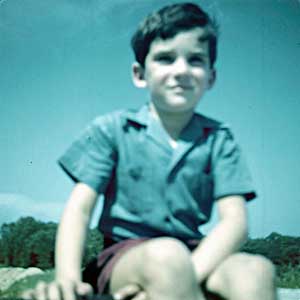 |
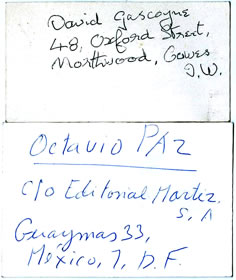 Poetic Addresses, written down for me by the poets in years gone by. |
|
|
|
|
© Robert Temple 2009-2022
|
|





















































